Suggested
News
Last updated: Thursday, March 27, 2025

Sidechains & Layer-2 Solutions 2025: Revolutionizing Blockchain Scalability and Slashing Fees
It’s March 27, 2025, and blockchain’s getting a turbo boost—sidechains and Layer-2 solutions are rewriting the rules. Imagine zipping through transactions faster than a Hanoi scooter, paying pennies instead of dollars in fees, all while keeping your crypto secure. From Polygon’s sidechain magic to Arbitrum’s rollup wizardry, these innovations are tackling blockchain’s biggest headache: scalability. With DeFi hitting $5 trillion and Bitcoin adoption soaring, let’s unpack how sidechains and Layer-2 are making crypto cheaper, faster, and ready for the masses—don’t blink, this revolution’s moving quick.
Why Scalability’s the 2025 Crypto Buzzword
Bitcoin does 7 transactions per second (TPS), Ethereum’s at 15—Visa laughs at 1,700. Enter sidechains and Layer-2: off-chain heroes easing mainnet congestion. By 2025, Layer-2’s total value locked (TVL) tops $38 billion (L2BEAT), and sidechains like Polygon push 65,000 TPS. Why now? DeFi’s $5T boom (Morningstar) and 420 million crypto users (Ventureburn) demand speed and affordability. In Saigon, a vendor swaps ETH for coffee via Polygon, skipping Ethereum’s $10 gas fees. Scalability isn’t a luxury—it’s the backbone of crypto’s next leap.
Sidechains vs. Layer-2: The Power Duo
Sidechains run parallel blockchains—think Polygon or Liquid Network—handling transactions independently, then syncing with the mainnet. They’re flexible, experimental, hitting thousands of TPS. Layer-2 (rollups, channels) builds atop Layer-1, like Arbitrum’s Optimistic Rollups or Bitcoin’s Lightning Network, bundling deals for efficiency. Polygon’s $0.01 fees crush Ethereum’s mainnet costs, while Lightning slashes BTC microtransaction prices. In Hanoi, a gamer mints NFTs gas-free on SKALE. Together, they’re scalability’s dynamic duo—fast, cheap, secure.

Real-World Wins in 2025
Sidechains and Layer-2 aren’t just tech hype—they’re life-changers. A Mekong farmer uses Polygon to track rice sales, cutting costs 90%. In HCMC, Lightning lets a street vendor take BTC for pho, no delay. Polygon’s 2.1-second blocks and Arbitrum’s 6.38 million daily transactions (Dexola) power DeFi and gaming. Developers love sidechains like SKALE for zero-fee DApps, while zkSync’s privacy rollups shield trades. From micro-payments to million-dollar swaps, these solutions are crypto’s everyday glue.
What’s Next for 2025?
By year-end, sidechains and Layer-2 go wilder: EIP-4844 (proto-danksharding) could slash rollup fees 90%, per Dexola. Specialized sidechains for AI or privacy pop up, and cross-L2 messaging gets standard (L2 Interoperability Alliance). Bitcoin’s Stacks adds DeFi with sBTC, pegged 1:1 to BTC. Analysts eye a $57 billion blockchain market (Grand View Research). Dig into CoinDesk or L2BEAT—it’s unfolding now. Will sidechains or rollups rule? The race is on.
Why You’ll Stick Around
This isn’t just a tech tale—it’s your front-row seat to crypto’s scalability fix. Sidechains and Layer-2 are your keys to cheaper trades, faster apps, and a blockchain that works for all. Searching ‘blockchain scalability 2025’ or ‘Layer-2 fee reduction’? You’re in deep. So, what’s your play—jump on the sidechain train or ride the Layer-2 wave?
Suggested Articles
For You
Related Articles
- Quantum Computing Threat to Crypto: Encryption Risks and Solutions in 2025
- Bitcoin Rebounds Strongly in 2025 Thanks to Trump’s Crypto Policies
- Sharding - Blockchain Scalability Solution and Its Implementation on Ethereum
- Blockchain Scalability Trilemma - Balancing Decentralization, Security, and Scalability
- Ethereum 2.0 One Year Later: Has the Big Switch Paid Off in 2025?
- Regulatory Rhythms: How Global Crypto Policies Are Shaping the Future
- Ink in 2025: Kraken’s Layer 2 Blockchain Revolutionizing DeFi with a Thriving Community
- Humanity Protocol in 2025: Robust Infrastructure and a Vibrant Community Without Airdrop Hype
- Solana Rollup Sparks Excitement with Active Community, Token Still Awaited in 2025
- Scroll (SCR) in 2025: The Layer 2 ZK-Rollup with Airdrop Power Scaling Ethereum












